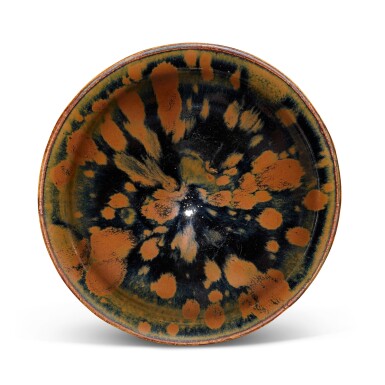
A superb Henan russet-splashed blacked-glazed 'partridge feather' temmoku bowl, Northern Song dynasty 北宋 河南窰鷓鴣斑斗笠盞
Lot Closed
December 16, 02:17 AM GMT
Estimate
150,000 - 200,000 HKD
Lot Details
Description
A superb Henan russet-splashed blacked-glazed 'partridge feather' temmoku bowl,
Northern Song dynasty
北宋 河南窰鷓鴣斑斗笠盞
12.1 cm
An American private collection.
Christie's New York, 21st September 1995, lot 180.
Collection of Mr and Mrs James E. Breece III
Christie's New York, 18th September 2003, lot 251.
Collection of Peter Scheinman (1932-2017), New York.
史蒂芬•瓊肯三世收藏
美國私人收藏
紐約佳士得1995年9月21日,編號180
James E. Breece III 伉儷收藏
紐約佳士得2003年9月18日,編號251
Peter Scheinman (1932-2017年) 收藏,紐約
This bowl is remarkable for its captivating pattern of irregular russet splashes on the interior, which creates a striking contrast to the lustrous dark brown glaze. Known as zhegu ban, or ‘partridge feathers’, this pattern evolved from the experimental nature of Song dynasty kilns as they competed in producing wares for the thriving tea market. Bowls covered in a lustrous dark-brown glaze heightened the aesthetic experience of drinking tea, which at the time was energetically whisked to produce a rich white froth. The present bowl is a particularly fine example of its type, as it features small and evenly applied flecks, suggesting it was made in the Northern Song period. Stonewares coated in rich dark glazes began to be produced in large numbers in the Tang period (618-907), with the finest examples made at kilns near the Yellow River. The monochromatic glazes soon led the way to painted or splashed designs, which were achieved by either splashing or applying with a brush an iron-oxide slip over the glaze. In the kiln, the gravity would pull the slip downwards creating irregular splashes or streaks. Not only were these wares particularly suitable for drinking whisked tea, the serendipitous nature of their glaze must have captivated the imagination of Song literati.
The mesmerising ‘partridge-feather’ glaze was produced at many kilns in both northern and southern China, attesting to its popularity. Most examples were made at kilns that produced Cizhou wares, such as the Guantai kilns in Hebei province, the Qinlongsi and Dangyangyu kilns in Henan province. Bowls of similar form, recovered at Guantai, Ci county, are illustrated in The Cizhou Kiln Site at Guantai, Beijing, 1997, col. pl. 29, figs 1 and 3, pl. 65, fig. 1; and a larger bowl from Dangyangyu, the glaze similarly covering also the interior of the foot, is published in Series of China’s Ancient Porcelain Kiln Sites. Dangyangyu Kiln of China, Beijing, 2011, pl. 56.
本品「鷓鴣斑」紋,揮灑褐斑於黑地之上,自然灑脫,兩相襯映,耀眼奔放。宋時,茶道興盛,製瓷工藝隨之發展蓬勃,百窰爭鳴,順應而生豐富多樣的釉色變化,鷓鴣斑紋即為其一。茶盌深褐釉色,可襯托茶沫細白,極富審美趣味,本品乃此類佼佼者,斑紋細緻勻麗,應屬北宋之作。 唐代始燒深色釉瓷,以黃河沿岸區域窰口最佳。單色釉瓷漸演變出各樣裝飾風格,運用含鐵量高化妝土,以繪畫、潑灑等技法上色;入窰後,釉面裝飾隨著溫度交融,或因地心引力下流,或細長如羽、或大小交錯,自然形成趣味各異之紋飾。此類茶盌,不僅適合用於茶席,釉彩千變萬化之面貌,引人入勝,亦深受宋代文人喜愛。
鷓鴣斑釉之燒製,南北皆有,多數製於河北磁州窰系窰址,如觀台窰,與河南當陽峪窰等。磁縣觀台窰曾出土類同造形茶盌,錄於《觀台磁州窰址》,北京,1997,彩圖29,圖1、3,圖版65,圖1;比較一件當陽峪盌,內外均施鷓鴣斑,尺寸較大,刊於《中國古瓷窰大系.中國當陽峪窰》,北京,2011年,圖版56。
You May Also Like










